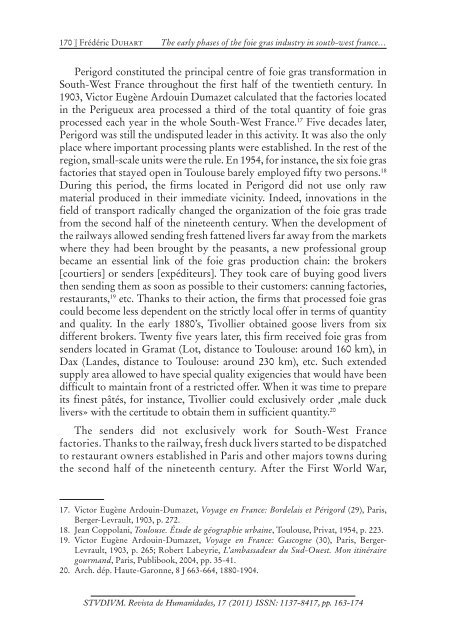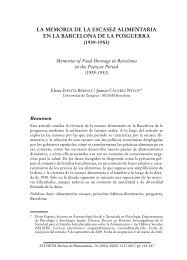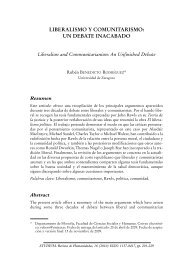- Page 1 and 2:
ISSN 1137-8417 9 7 7 1 1 3 7 8 4 1
- Page 3 and 4:
REDACCIÓN, CORRESPONDENCIA E INTER
- Page 6 and 7:
Índice STVDIVM 17 (2011) Stvdivm.
- Page 8 and 9:
contents STVDIVM 17 (2011) Stvdivm.
- Page 10 and 11:
14 ][ Sergio Martínez García Rabi
- Page 12 and 13:
16 ][ Sergio Martínez García Rabi
- Page 14 and 15:
18 ][ Sergio Martínez García Rabi
- Page 16 and 17:
20 ][ Sergio Martínez García Rabi
- Page 18 and 19:
22 ][ Sergio Martínez García Rabi
- Page 20 and 21:
24 ][ Sergio Martínez García Rabi
- Page 22 and 23:
26 ][ Sergio Martínez García Rabi
- Page 24 and 25:
28 ][ Sergio Martínez García Rabi
- Page 26 and 27:
30 ][ Sergio Martínez García Rabi
- Page 28 and 29:
32 ][ Sergio Martínez García Rabi
- Page 30 and 31:
34 ][ Sergio Martínez García Rabi
- Page 32 and 33:
36 ][ Sergio Martínez García Rabi
- Page 35 and 36:
UN ANÁLISIS DE CONTABILIDAD COMERC
- Page 37 and 38:
Un análisis de contabilidad comerc
- Page 39 and 40:
Un análisis de contabilidad comerc
- Page 41 and 42:
Un análisis de contabilidad comerc
- Page 43 and 44:
Un análisis de contabilidad comerc
- Page 45 and 46:
Un análisis de contabilidad comerc
- Page 47 and 48:
Un análisis de contabilidad comerc
- Page 49 and 50:
Un análisis de contabilidad comerc
- Page 51 and 52:
Un análisis de contabilidad comerc
- Page 53 and 54:
Un análisis de contabilidad comerc
- Page 55 and 56:
Un análisis de contabilidad comerc
- Page 57 and 58:
Un análisis de contabilidad comerc
- Page 59:
Un análisis de contabilidad comerc
- Page 62 and 63:
66 ][ Juan Abella Samitier Los orí
- Page 64 and 65:
68 ][ Juan Abella Samitier Los orí
- Page 66 and 67:
70 ][ Juan Abella Samitier Los orí
- Page 68 and 69:
72 ][ Juan Abella Samitier Los orí
- Page 70 and 71:
74 ][ Juan Abella Samitier Los orí
- Page 72 and 73:
76 ][ Juan Abella Samitier Los orí
- Page 74 and 75:
78 ][ Juan Abella Samitier Los orí
- Page 76 and 77:
80 ][ Juan Abella Samitier Los orí
- Page 78 and 79:
82 ][ Juan Abella Samitier Los orí
- Page 80 and 81:
84 ][ Juan Abella Samitier Los orí
- Page 82 and 83:
86 ][ Juan Abella Samitier Los orí
- Page 84 and 85:
88 ][ Juan Abella Samitier Los orí
- Page 86 and 87:
90 ][ Juan Abella Samitier Los orí
- Page 88 and 89:
92 ][ Juan Abella Samitier Los orí
- Page 90 and 91:
94 ][ Juan Abella Samitier Los orí
- Page 93 and 94:
VIOLENCIA Y PODER EN LA RIBERA DEL
- Page 95 and 96:
Violencia y poder en la ribera del
- Page 97 and 98:
Violencia y poder en la ribera del
- Page 99 and 100:
Violencia y poder en la ribera del
- Page 101 and 102:
Violencia y poder en la ribera del
- Page 103 and 104:
Violencia y poder en la ribera del
- Page 105 and 106:
Violencia y poder en la ribera del
- Page 107 and 108:
Violencia y poder en la ribera del
- Page 109 and 110:
Violencia y poder en la ribera del
- Page 111 and 112:
Violencia y poder en la ribera del
- Page 113 and 114:
Violencia y poder en la ribera del
- Page 115 and 116: Violencia y poder en la ribera del
- Page 117 and 118: Violencia y poder en la ribera del
- Page 119: Violencia y poder en la ribera del
- Page 122 and 123: 126 ][ José Luis Castán Esteban L
- Page 124 and 125: 128 ][ José Luis Castán Esteban L
- Page 126 and 127: 130 ][ José Luis Castán Esteban L
- Page 128 and 129: 132 ][ José Luis Castán Esteban L
- Page 130 and 131: 134 ][ José Luis Castán Esteban L
- Page 132 and 133: 136 ][ José Luis Castán Esteban L
- Page 134 and 135: 138 ][ José Luis Castán Esteban L
- Page 136 and 137: 140 ][ José Luis Castán Esteban L
- Page 138 and 139: 142 ][ José Luis Castán Esteban L
- Page 140 and 141: 144 ][ José Luis Castán Esteban L
- Page 142 and 143: 146 ][ José Luis Castán Esteban L
- Page 144 and 145: 148 ][ Fernando Serrano Larráyoz E
- Page 146 and 147: 150 ][ Fernando Serrano Larráyoz E
- Page 148 and 149: 152 ][ Fernando Serrano Larráyoz E
- Page 150 and 151: 154 ][ Fernando Serrano Larráyoz E
- Page 152 and 153: 156 ][ Fernando Serrano Larráyoz E
- Page 154 and 155: 158 ][ Fernando Serrano Larráyoz E
- Page 156 and 157: 160 ][ Fernando Serrano Larráyoz E
- Page 158 and 159: 162 ][ Fernando Serrano Larráyoz E
- Page 160 and 161: 164 ][ Frédéric Duhart The early
- Page 162 and 163: 166 ][ Frédéric Duhart The early
- Page 164 and 165: 168 ][ Frédéric Duhart The early
- Page 168 and 169: 172 ][ Frédéric Duhart The early
- Page 170 and 171: 174 ][ Frédéric Duhart The early
- Page 172 and 173: 176 ][ Hugo Roberto Basualdo Mirand
- Page 174 and 175: 178 ][ Hugo Roberto Basualdo Mirand
- Page 176 and 177: 180 ][ Hugo Roberto Basualdo Mirand
- Page 178 and 179: 182 ][ Hugo Roberto Basualdo Mirand
- Page 180 and 181: 184 ][ Hugo Roberto Basualdo Mirand
- Page 182 and 183: 186 ][ Hugo Roberto Basualdo Mirand
- Page 184 and 185: 188 ][ Hugo Roberto Basualdo Mirand
- Page 187 and 188: UN GÉNERO INSTAURADO: LA SiLva Cur
- Page 189 and 190: Un género instaurado: la Silva cur
- Page 191 and 192: Un género instaurado: la Silva cur
- Page 193 and 194: Un género instaurado: la Silva cur
- Page 195 and 196: Un género instaurado: la Silva cur
- Page 197 and 198: Un género instaurado: la Silva cur
- Page 199 and 200: Un género instaurado: la Silva cur
- Page 201 and 202: Un género instaurado: la Silva cur
- Page 203 and 204: Un género instaurado: la Silva cur
- Page 205 and 206: Un género instaurado: la Silva cur
- Page 207 and 208: Un género instaurado: la Silva cur
- Page 209 and 210: Un género instaurado: la Silva cur
- Page 211 and 212: Un género instaurado: la Silva cur
- Page 213 and 214: Resumen ¿POR QUÉ Sor PatroCiNio?
- Page 215 and 216: ¿Por qué Sor Patrocinio? la elecc
- Page 217 and 218:
¿Por qué Sor Patrocinio? la elecc
- Page 219 and 220:
¿Por qué Sor Patrocinio? la elecc
- Page 221 and 222:
¿Por qué Sor Patrocinio? la elecc
- Page 223 and 224:
¿Por qué Sor Patrocinio? la elecc
- Page 225 and 226:
¿Por qué Sor Patrocinio? la elecc
- Page 227 and 228:
¿Por qué Sor Patrocinio? la elecc
- Page 229 and 230:
¿Por qué Sor Patrocinio? la elecc
- Page 231 and 232:
¿Por qué Sor Patrocinio? la elecc
- Page 233 and 234:
¿Por qué Sor Patrocinio? la elecc
- Page 235 and 236:
¿Por qué Sor Patrocinio? la elecc
- Page 237 and 238:
¿Por qué Sor Patrocinio? la elecc
- Page 239 and 240:
¿Por qué Sor Patrocinio? la elecc
- Page 241 and 242:
¿Por qué Sor Patrocinio? la elecc
- Page 243:
¿Por qué Sor Patrocinio? la elecc
- Page 246 and 247:
250 ][ R . M .ª Arráez, E . Jense
- Page 248 and 249:
252 ][ R . M .ª Arráez, E . Jense
- Page 250 and 251:
254 ][ R . M .ª Arráez, E . Jense
- Page 252 and 253:
256 ][ R . M .ª Arráez, E . Jense
- Page 254 and 255:
258 ][ R . M .ª Arráez, E . Jense
- Page 256 and 257:
260 ][ R . M .ª Arráez, E . Jense
- Page 258 and 259:
262 ][ R . M .ª Arráez, E . Jense
- Page 260 and 261:
264 ][ R . M .ª Arráez, E . Jense
- Page 262 and 263:
266 ][ R . M .ª Arráez, E . Jense
- Page 264 and 265:
268 ][ R . M .ª Arráez, E . Jense
- Page 266 and 267:
270 ][ R . M .ª Arráez, E . Jense
- Page 268 and 269:
272 ][ R . M .ª Arráez, E . Jense
- Page 271 and 272:
EL AGUA, FUENTE DE RIQUEZA INAGOTAB
- Page 273 and 274:
El agua, fuente de riqueza inagotab
- Page 275 and 276:
El agua, fuente de riqueza inagotab
- Page 277 and 278:
El agua, fuente de riqueza inagotab
- Page 279 and 280:
El agua, fuente de riqueza inagotab
- Page 281 and 282:
El agua, fuente de riqueza inagotab
- Page 283 and 284:
El agua, fuente de riqueza inagotab
- Page 285 and 286:
El agua, fuente de riqueza inagotab
- Page 287 and 288:
El agua, fuente de riqueza inagotab
- Page 289 and 290:
El agua, fuente de riqueza inagotab
- Page 291 and 292:
El agua, fuente de riqueza inagotab
- Page 293 and 294:
El agua, fuente de riqueza inagotab
- Page 295 and 296:
El agua, fuente de riqueza inagotab
- Page 297:
El agua, fuente de riqueza inagotab
- Page 300 and 301:
304 ][ Constantino Gonzalo Morell E
- Page 302 and 303:
306 ][ Constantino Gonzalo Morell E
- Page 304 and 305:
308 ][ Constantino Gonzalo Morell E
- Page 306 and 307:
310 ][ Constantino Gonzalo Morell E
- Page 308 and 309:
312 ][ Constantino Gonzalo Morell E
- Page 310 and 311:
314 ][ Constantino Gonzalo Morell E
- Page 312 and 313:
316 ][ Constantino Gonzalo Morell E
- Page 314 and 315:
318 ][ Constantino Gonzalo Morell E
- Page 316 and 317:
320 ][ Constantino Gonzalo Morell E
- Page 318 and 319:
322 ][ Constantino Gonzalo Morell E
- Page 320 and 321:
324 ][ Constantino Gonzalo Morell E
- Page 323 and 324:
EL RECURSO AL hUMOR COMO ELEMENTO D
- Page 325 and 326:
El recurso al humor como elemento d
- Page 327 and 328:
El recurso al humor como elemento d
- Page 329 and 330:
El recurso al humor como elemento d
- Page 331 and 332:
El recurso al humor como elemento d
- Page 333 and 334:
El recurso al humor como elemento d
- Page 335 and 336:
El recurso al humor como elemento d
- Page 337 and 338:
El recurso al humor como elemento d
- Page 339 and 340:
MIGUEL FLETA (1897-1938) Y TURANDOT
- Page 341 and 342:
Miguel Fleta (1897-1938) y Turandot
- Page 343 and 344:
Miguel Fleta (1897-1938) y Turandot
- Page 345 and 346:
Miguel Fleta (1897-1938) y Turandot
- Page 347 and 348:
Miguel Fleta (1897-1938) y Turandot
- Page 349 and 350:
Miguel Fleta (1897-1938) y Turandot
- Page 351 and 352:
Miguel Fleta (1897-1938) y Turandot
- Page 353 and 354:
Miguel Fleta (1897-1938) y Turandot
- Page 355:
Reseñas bibliográficas / Reviews
- Page 358 and 359:
362 ][ Reseñas bibliográficas / R
- Page 360 and 361:
364 ][ Reseñas bibliográficas / R
- Page 362 and 363:
366 ][ Reseñas bibliográficas / R
- Page 364 and 365:
Reseñas bibliográficas / Reviews
- Page 366 and 367:
Reseñas bibliográficas / Reviews
- Page 368 and 369:
Reseñas bibliográficas / Reviews
- Page 370 and 371:
Reseñas bibliográficas / Reviews
- Page 372 and 373:
Reseñas bibliográficas / Reviews
- Page 374 and 375:
Reseñas bibliográficas / Reviews
- Page 376 and 377:
Sumarios/Summaries
- Page 378 and 379:
382 ][ Sumarios / Summaries Juanjo
- Page 380 and 381:
384 ][ Sumarios / Summaries desde l
- Page 382 and 383:
386 ][ Sumarios / Summaries Constan
- Page 384 and 385:
summaries STVDIVM 17 (2011) Stvdivm
- Page 386 and 387:
Sumarios / Summaries ][ 389 the dif
- Page 388 and 389:
Sumarios / Summaries ][ 391 Rosa Ma
- Page 390 and 391:
StvdivM. reviSta de HuMaNidadeS STv
- Page 392 and 393:
NORMAS PARA LA PRESENTACIÓN DE ORI
- Page 394 and 395:
MANUSCRIPTS SUBMISSION STvdivm ][ 3
- Page 396 and 397:
STvdivm ][ 399 Deseamos iniciar y m
- Page 398:
BOLETÍN DE SUSCRIPCIÓN STvdivm ][




